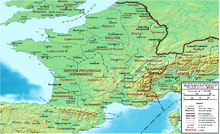Dux provinciae Sequanicae
The Dux provinciae Sequanicae (literally: “General of the Sequania Province”) was a high officer in the late antique army of the Western Roman Empire and the commander in chief of the limit units stationed in the Maxima Sequanorum province .
The command area of the Dux comprised the section (tractus) of the Rhine border between Eschenz and Breisach am Rhein . He was under the Magister Peditum (commander in chief of the infantry) and the Magister equitum (commander in chief of the cavalry). At the imperial court, a Dux limitis belonged to the highest class of viri spectabiles .
development
The office is only known from the western Notitia Dignitatum . In the course of the imperial and administrative reform of Diocletian , the territory of Germania superior was reorganized into two provinces around 297, Germania I and Maxima Sequanorum . Since the military commanders had been separated from the civilian authorities, the border troops stationed there were subordinate to two Duces limites , the Dux Germaniae primae and the Dux provinciae Sequanicae , as is customary elsewhere . At the time the Notitia was written, the provincial capital Vesontio was probably also the seat of the Dux of Sequania. Their troops were responsible for border protection on the high and southern Upper Rhine. The border fortifications of the province were again considerably expanded under Valentinian I. Here were u. a. the bridgeheads Sponeck and Basel / Basilia on the right bank of the Rhine , but also the Castrum Rauracense built or renovated. In addition, numerous stone watchtowers were built on the Upper Rhine. In addition, there was an early warning network from the Alamanni hilltop settlements on the right bank of the Rhine to secure the apron. They were in close contact with the garrisons of the Roman border fort. The Dux is mentioned in Chapter I of the Notitia Dignitatum as one of the twelve Dux limites of the Western Empire, but like the Dux tractus Armoricani et Nervicani , it no longer appears in the list of the Commander-in-Chief of the Western Foot Troops . This could mean that the ducat no longer existed at the time of the presumed final version of the Western Notitia (the period between 395 and 425). From 423 federated Burgundy tribes were settled in the Limes section of the Dux. They soon expanded their sphere of influence and replaced the Roman border defense from 460 at the latest. The addition " provinciae " is otherwise only used by the military leaders of the western Roman provinces Tripolitania, Mauritaniae et Caesariensis and Valeria .
Administrative staff
The Officium (administrative staff) of the Dux comprised the following offices (Officium autem habet idem vir spectabilis dux hoc modo) :
- Principem ex officiis magistrorum militum praesentalium aparte peditum (head of the chancellery from the ranks of the army, appointed by the army master)
- Numerarium ut supra (= as above, i.e. paymaster of the army, also appointed by the army master)
- Commentariensem ut supra (Legal scholars of the army, appointed by the army master)
- Adiutorem (assistant)
- Subadiuuam (assistant)
- Regrendarium (administrator)
- Exceptores (lawyers)
- Singulares et reliquos officiales (bodyguards and other officials)
troops
The list of troops handed down in the Notia has presumably been incompletely copied as it contains only one unit. However, it cannot have provided the entire provincial force in the 5th century. Other units listed in the Notitia could originally have been stationed or recruited in the Sequania .
Distributio Numerorum
The following units were possibly still available for the Dux :
| units | comment | Illustration |
|---|---|---|
| Comitatenses | ||
| Legio prima Martia | There is clear archaeological evidence of the presence of this Comitatense unit on the Upper Rhine for the early 4th century . It is mainly attested by finds of brick stamps. On some of them, however, the name of the troop is reproduced in such strong ligature that their assignment is not finally certain. The finds of their bricks in the entire area of the Sequania suggest that the Legion was split up into vexillations after their advance into this border section and then distributed over several locations. | |
| Vesontes | One of the eight Legiones comitatenses listed in the Magister Peditum's list of troops . According to ND, they served in the field army of the Comes Hispaniarum . Your name was probably derived from the provincial capital Vesontio . | |
| Sequani | These infantrymen were among the auxilia palatina units (guards) of the Magister Peditum and were part of the field army of the Comes Illyrici towards the middle of the 5th century . Their name was either derived from the Seine River in France or refers to the Celto-Roman Sequan people . | |
| Ala secunda Valeria Sequanor | This cavalry unit in the army of Dux Raetiae is known from the Notitia . They belonged to the Limitanei and were stationed in the Vemania / Isny fort . Presumably, the majority of the members of this troop were also Sequaner, who perhaps had originally been recruited in the area of Vesontio (between Saone and western Swiss Jura). | |
| Limitanei | ||
| Milites Latavienses (= Batavi or Latovici) | The only unit given in the chapter of the Dux. She was one of the Limitanei and was stationed in Fort Olinone / Olitone . Maybe today's Besançon / Vesontio or a fort in Oelenburg near Reiningue in Alsace. |
literature
- Michaela Konrad , Christian Witschel (Organizer): Conference report on the international colloquium “Roman legionary camps in the Rhine and Danube provinces” - Nuclei of late antique and early medieval life? Bavarian Academy of Sciences, Munich from March 28-30, 2006, pp. 11-13. PDF (353 kB)
- Michaela Konrad, Christian Witschel: Late antiquity legion camps in the Rhine and Danube provinces of the Roman Empire. A contribution to the continuity debate . In: Michaela Konrad, Christian Witschel (eds.): Roman legionary camps in the Rhine and Danube provinces - nuclei of late antique-early medieval life? . Beck, Munich 2011, ISBN 978-3-7696-0126-8 , p. 3 ff.
- Michael S. DuBois: Auxillae: A Compendium of Non-Legionary Units of the Roman Empire. Lulu Press 2015, ISBN 978-1-329-63758-0 .
- Michael Zerjadtke: The Dux office in late antiquity and the early Middle Ages: The ducatus in the field of tension between Roman influence and its own development. Verlag Walter de Gruyter, Berlin 2018.
Remarks
- ↑ Notitia Dignitatum occ. V and VI.
- ↑ Michael Zerjadtke 2018, Section 7.2.2
- ↑ sub dispositions
- ↑ Notitia Dignitatum occ. XXXVI, 5.






